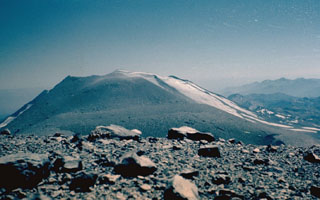Report on Nevados de Chillan (Chile) — July 1979
Scientific Event Alert Network Bulletin, vol. 4, no. 7 (July 1979)
Managing Editor: David Squires.
Nevados de Chillan (Chile) Eruption continuing since 1973
Please cite this report as:
Global Volcanism Program, 1979. Report on Nevados de Chillan (Chile) (Squires, D., ed.). Scientific Event Alert Network Bulletin, 4:7. Smithsonian Institution. https://doi.org/10.5479/si.GVP.SEAN197907-357070
Nevados de Chillan
Chile
36.868°S, 71.378°W; summit elev. 3180 m
All times are local (unless otherwise noted)
When visited by Oscar González-Ferrán on 21 February 1979, the eruption of Nevados de Chillán that began in July 1973 was continuing. An explosion lasting 1.5 hours produced a cloud, containing bombs, [blocks], and ash, that rose almost 2 km before reaching a windy layer that prevented further upward movement. The new cone had grown to about the same height as the adjacent 1906 cone [Volcán Nuevo], where fumarolic activity persisted (figure 1).
 |
Figure 1. Sketch of the Nevados de Chillán complex; the upper sketch shows details of the area active on 21 February 1979. Courtesy of Oscar González-Ferrán. |
[Hugo Moreno reports that by 1983 the phreatomagmatic eruption had almost ended. From 1983 to 1987, only a few explosions have been reported (about one every 2 months). These generated small pyroclastic flows, by column collapse, over the snow cover. By late 1987, the dome extruded earlier in the eruption had been covered by tephra that built a new cone (named Tata) about 30 m higher than neighboring Volcán Nuevo.]
Further Reference. Deruelle, B., 1977, New activity of the Nevados de Chillán: C.R. Acad. Sci. Paris, serie D, v. 284, p. 1651-1654.
Geological Summary. The compound volcano of Nevados de Chillán is one of the most active of the Central Andes. Three late-Pleistocene to Holocene stratovolcanoes were constructed along a NNW-SSE line within three nested Pleistocene calderas, which produced ignimbrite sheets extending more than 100 km into the Central Depression of Chile. The dominantly andesitic Cerro Blanco (Volcán Nevado) stratovolcano is located at the NW end of the massif. Volcán Viejo (Volcán Chillán), which was the main active vent during the 17th-19th centuries, occupies the SE end. The Volcán Nuevo lava-dome complex formed during 1906-1945 on the NW flank of Viejo. The Volcán Arrau dome complex was then constructed on the SE side of Volcán Nuevo between 1973 and 1986, and eventually exceeded its height. Smaller domes or cones are present in the 5-km valley between the two major edifices.
Information Contacts: O. González-Ferrán, Univ. de Chile, Santiago.

